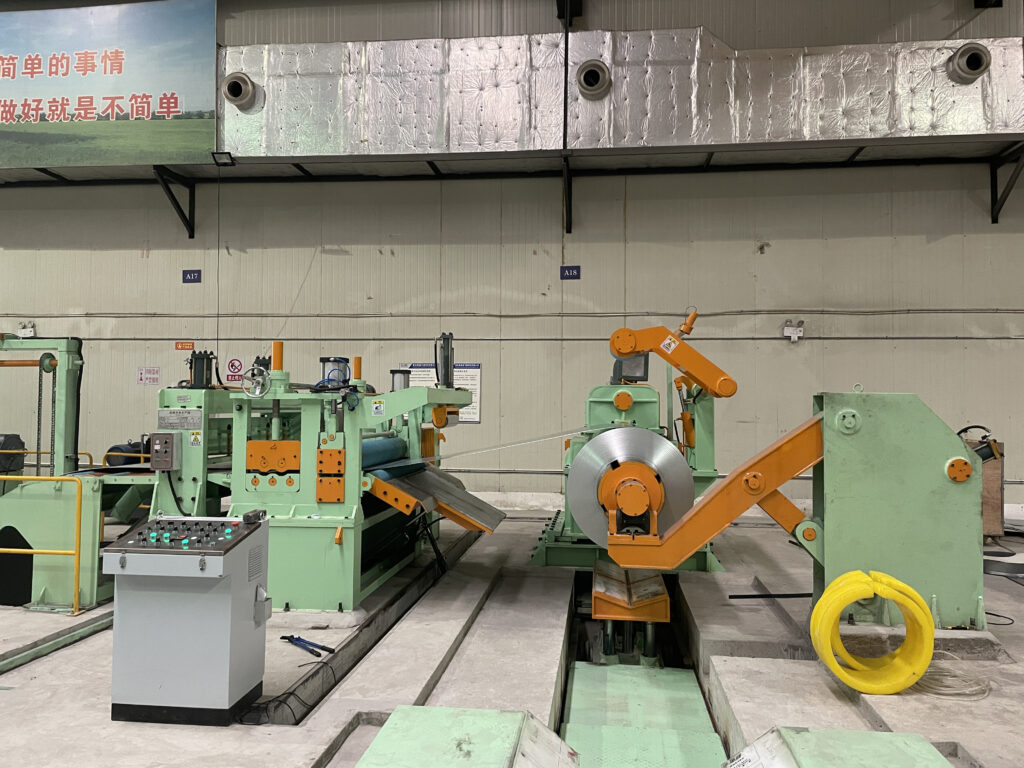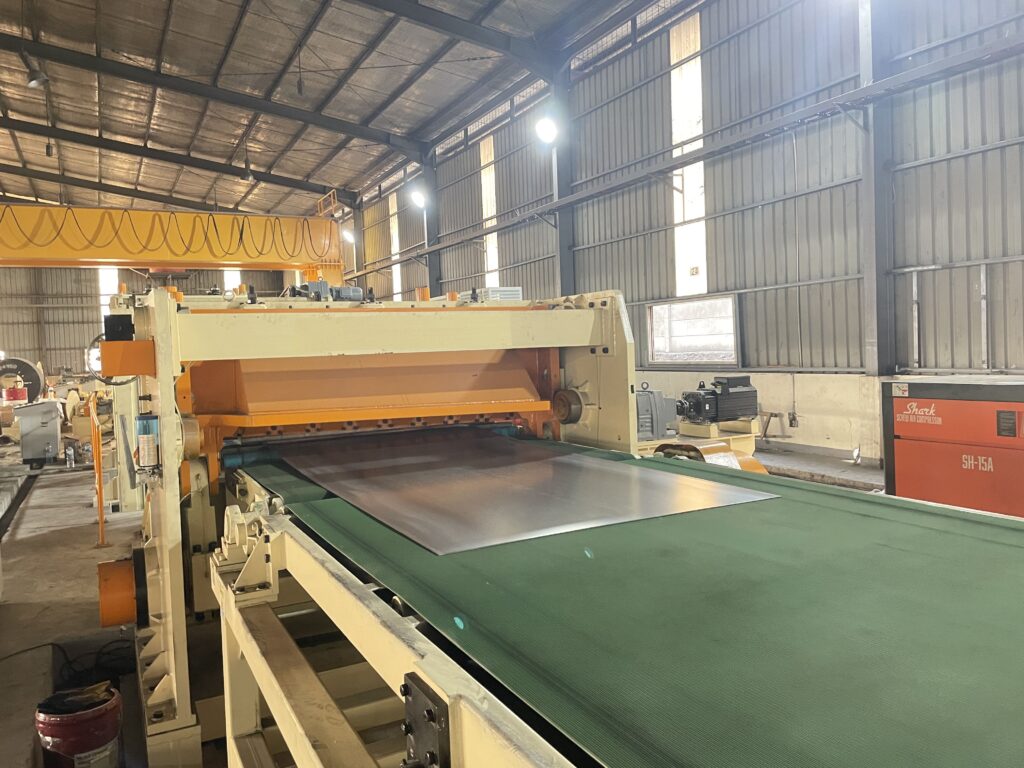Expert Guide to Troubleshooting and Optimizing Metal Slitting vs. Blanking with MaxdoMachine MD Series
Discover authoritative insights and real-world case studies on metal slitting vs. blanking quality issues. Learn detailed MD series specs, troubleshooting tips, and ROI results to optimize your coil processing operations with MaxdoMachine’s advanced equipment.
Metal slitting and blanking remain cornerstone techniques in advanced metal coil processing, each demanding precision engineering to meet escalating industry standards in 2025. Metal slitting involves the razor-sharp segmenting of wide coils into narrower strips, where achieving superior edge quality and maintaining sub-millimeter dimensional tolerance are critical for downstream applications in automotive, aerospace, and electronics sectors. Conversely, blanking focuses on cutting metal sheets into precise shapes or lengths, emphasizing tight length tolerances and minimal burr formation through optimized punch-die clearances and advanced tooling materials.
Drawing from MaxdoMachine’s MD series—integrating CNC blade alignment, servo-driven tension control, and real-time PLC feedback—this guide delves into the nuanced quality challenges inherent to both processes. Leveraging real manufacturing case studies and proven technical solutions, it offers systematic troubleshooting strategies enabling production engineers and managers to elevate product quality, operational uptime, and throughput efficiency with unmatched precision and reliability.
Understanding Key Metal Processing Challenges
Common Quality Issues in Slitting
Slitting processes frequently encounter challenges related to edge quality and dimensional accuracy. One common problem is the formation of edge burrs and roughness, typically caused by blade wear or incorrect blade clearance; these defects often lead to increased rework and material waste. Additionally, edge wave and deformation can arise when coil tension is uneven or when recoiling is improperly managed—issues that compromise the performance of downstream forming operations. Furthermore, inconsistencies in width and length can occur due to tooling misalignment or suboptimal machine calibration, resulting in dimensions that fall outside acceptable tolerances and affecting the overall product quality.

Critical Quality Concerns in Blanking
Blanking operations face their own set of unique hurdles, with length tolerance deviations being a foremost concern. Even slight variations in the length of blanked sheets can disrupt automated production lines and complicate assembly. Excessive burr formation on cut edges not only increases finishing costs but can also undermine the structural integrity of components. Lastly, sheet warping or distortion—often caused by uneven leveling or residual stresses trapped within the coil—produces warped sheets that are difficult to handle and may necessitate costly reprocessing or scrappage. Addressing these issues effectively is essential for achieving high-quality blanked products suitable for precise manufacturing applications.
Systematic Solutions for Quality Challenges
Effective Approaches to Troubleshooting Slitting Quality Issues
A proactive maintenance strategy is vital to preserving blade performance and minimizing defects. Blades should be routinely inspected and replaced according to the specific material type and thickness being processed. Equally important is the precise adjustment of blade clearance, which must be tailored to the metal grade and thickness; optimal clearance reduces burr formation significantly.
Beyond blade management, controlling coil tension plays a critical role. Advanced tension control systems help maintain steady tension throughout the slitting process, preventing deformation and edge waves. For processing wider coils, particularly with machines like the MD-1650 and MD-2200, incorporating data-driven feedback loops and vibration damping mechanisms greatly enhances stability and strip quality.
Regular calibration of slitters ensures blades remain accurately aligned, which is essential for consistent slit width. Furthermore, integrating vision-guided edge control systems provides real-time monitoring and automatic corrections, allowing operators to maintain tolerance targets with greater confidence.
Best Practices for Optimizing Blanking Processes
Blanking efficiency and precision depend heavily on the condition and calibration of servo-shear equipment. Periodic calibration keeps length tolerances within tight limits—commonly around ±0.15 mm—ensuring reliable sheet dimensions. Maintaining blade sharpness and carefully monitoring blade gaps are equally crucial in minimizing burr formation and achieving clean cuts.
Preparation of the coil material before blanking has a significant impact on final sheet quality. Selecting leveler roll configurations appropriate for the specific material thickness and grade prevents warping and distortion. Additionally, applying stress-relief treatments to coils prior to blanking can mitigate internal stresses that would otherwise cause sheet deformation.

To maintain consistent quality, continuous process monitoring is recommended. Implementing inline sensors to measure sheet length and detect burrs allows for prompt adjustments. Establishing a preventive maintenance schedule further ensures early identification of potential issues, helping to avoid costly production interruptions.
| Key Focus Area | Best Practices | Benefits |
|---|---|---|
| Blade Management | Routine inspections, tailored clearance settings | Reduced burr, extended blade life |
| Tension Control | Advanced tension systems, vibration damping | Improved edge quality, reduced deformation |
| Machine Calibration | Regular alignment checks, vision-guided control | Consistent slit widths, real-time corrections |
| Shear Calibration | Servo-shear tuning, blade gap monitoring | Tight length tolerances, cleaner cuts |
| Coil Preparation | Optimized leveler rolls, pre-stress relief | Minimized warping, improved sheet flatness |
| Monitoring & Maintenance | Inline sensors, preventive schedules | Early issue detection, sustained quality |
By adopting these comprehensive and tailored solutions, metal processing operations can effectively address the unique challenges inherent in both slitting and blanking, leading to enhanced product quality and operational efficiency.
How to Implement These Solutions in Your Facility?
| Implementation Phase | Key Focus | Outcome |
|---|---|---|
| Initial Assessment | KPI measurement (burrs, variance, scrap) | Clear understanding of quality gaps |
| Equipment Selection | MD series model alignment with coil specs | Optimal machinery fit for production needs |
| Installation & Calibration | Precise setup, system integration | Maximized equipment accuracy and efficiency |
| Operator Training | Hands-on guidance on setup and maintenance | Skilled staff supporting consistent output |
| Continuous Improvement | Data-driven monitoring and process optimization | Sustainable quality and productivity gains |
A successful implementation begins with a comprehensive evaluation of your current slit and blanked product quality. Measuring key performance indicators such as burr height, dimensional variances, and scrap rates will provide clear insight into areas needing improvement.
Next, carefully align your coil processing needs—including material width, thickness, and operational speed—with the appropriate MD series machinery. For instance, the MD-850 suits narrow to mid-width coils, the MD-1350 and MD-1650 cover mid-range processing, and the MD-2200 is optimized for wide or heavy coils, ensuring equipment matches your production demands precisely.
Installation and calibration require close collaboration with OEM engineers to guarantee precise setup tailored to your operation. This phase involves integrating critical systems like tension control, blade positioning mechanisms, and advanced vision-guided monitoring to deliver optimal line performance.
Equally important is the training of operators. Providing supervised, hands-on instruction focused on machine setup, troubleshooting techniques, and preventive maintenance enables your team to maintain equipment reliability and swiftly address any issues.
Finally, adopting a philosophy of continuous improvement is essential. Utilize production data analytics to vigilantly track equipment performance and product quality, allowing you to proactively identify trends, address emerging challenges, and fine-tune processes for sustained operational excellence.
How Does MaxdoMachine’s MD Series Support Your Metal Processing Needs?
MaxdoMachine’s MD series is designed to deliver flexible and robust solutions tailored specifically for the demanding realities of coil metal processing. These machines span a wide range of working widths—from as narrow as 20 mm up to 2150 mm—and accommodate material thicknesses ranging from 0.3 mm to 12 mm, depending on the model. With processing speeds reaching up to 250 meters per minute, the MD series adapts seamlessly to different production tempos while maintaining optimized power efficiency for high-volume operations.
In practical terms, the MD series has demonstrated significant performance improvements in real-world settings. For example, the MD-1350 model helped an automotive supplier double their production throughput within just six months, simultaneously reducing scrap rates by 15%. Similarly, when deployed at a steel service center, the MD-2200 contributed to a 40% reduction in edge defects, alongside a 30% increase in throughput over the course of one year.
Technologically, these machines incorporate advanced features essential for precision and operational stability. Integrated tension control combined with servo-driven blades guarantees consistent dimensional accuracy. Cutting-edge vision systems provide real-time edge guide corrections, ensuring uniform slit widths even at high speeds. Furthermore, the modular architecture of the MD series supports straightforward maintenance, easy upgrades, and customization, empowering manufacturers to evolve their production lines without extensive downtime.
When compared with other market offerings, the MD series distinguishes itself through a balanced combination of accuracy, speed, and durability—all backed by comprehensive maintenance strategies and expert-led training programs designed to maximize uptime and product quality. This holistic approach makes the MD series a reliable choice for metal processing facilities aiming to optimize performance without sacrificing flexibility or precision.
Industry Standards and Compliance You Should Expect
Compliance with internationally recognized standards is fundamental to ensuring consistent quality and safety in metal processing operations. The ISO 9001:2015 certification, for example, establishes a robust framework for quality management systems that help maintain uniform product standards and optimize process controls. In terms of workplace safety, adherence to OSHA protocols ensures that machines are equipped with adequate guarding, emergency stop functions, and designs that prioritize operator protection.
From a materials perspective, supporting standards such as ASTM, JIS, and DIN for steel and alloy grading guarantees that processed metals meet stringent global quality requirements. This alignment facilitates compatibility across diverse supply chains and manufacturing environments.
Performance-wise, operators can expect yields and processing speeds that are on par with leading industry benchmarks, as continuously validated through extensive customer feedback and real-world production data.
How to Verify Effectiveness and ROI
Measuring the success of quality improvements and investments involves a clear focus on key performance indicators (KPIs). Monitoring scrap rates, burr dimensions, dimensional tolerances, and equipment uptime before and after implementing changes provides tangible evidence of progress.
Further, analyzing production data enables quantification of throughput gains and reductions in maintenance costs, offering a comprehensive view of operational efficiency. To maintain high standards, conducting regular quality audits that compare current metrics against industry benchmarks and documented case studies is essential. This iterative validation process helps sustain continuous improvement and maximize return on investment.
Conclusion
Efficiently resolving quality challenges in metal slitting and blanking demands not only a deep understanding of each process’s specific nuances but also the application of cutting-edge, data-driven solutions such as those inherent in MaxdoMachine’s MD series. By leveraging features like servo-controlled tension management, CNC blade alignment, and integrated PLC feedback loops, the MD series empowers operators to maintain razor-sharp edge precision and minimize burr formation even under high-throughput conditions. Real-world implementations demonstrate that facilities adopting these technologies experience significant gains—in some cases, reducing material scrap by over 15% and boosting operational uptime by 20%, directly enhancing profitability and product consistency. Furthermore, embedding predictive maintenance protocols and automated quality monitoring fosters proactive issue detection, enabling swift corrective actions before defects escalate.
Partnering with MaxdoMachine’s technical team ensures a tailored approach to equipment optimization, blending industry-leading machinery with expert process consulting to align with specific production goals and compliance requirements. This collaboration drives measurable improvements in overall equipment effectiveness (OEE), first-pass quality rates exceeding 98%, and throughput scalability. In a 2025 manufacturing landscape where precision, efficiency, and sustainability define competitive advantage, maximizing MD series capabilities is essential for any forward-thinking metal processing operation poised to lead rather than follow.




